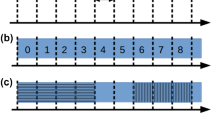Abstract
Grids consist of the aggregation of numerous dispersed computational and storage resources, able to satisfy even the most demanding computing jobs. An important aspect of Grid deployment is the allocation and activation of installed network capacity, needed to transfer data and jobs to and from remote resources. Due to the data-intensive nature of Grid jobs, it is expected that optical transport networks will play an important role in Grid deployment. As Grids possibly consist of high numbers of resources, and users, solving the network dimensioning problem (i.e. determining the number of wavelength channels per fiber and wavelength granularity required) using straightforward Integer Linear Programs (ILP) does not scale well with increasing number of jobs. Therefore, we propose the use of Divisible Load Theory (DLT) when modeling the OCS (with wavelength translation) dimensioning problem in this context. We compare this approach to both an exact ILP and heuristic (derived from the exact ILP) approach as a function of the job arrival process, network related parameters and the Grid job scheduling strategy on the Grid. Results show the convergence of the DLT-based and the exact ILP approach, which indicates that the DLT-based approach is of practical use in cases where the exact ILP-based problem becomes intractable. We study an excess load scenario and evaluate the network cost for varying wavelength granularity, fiber/wavelength cost models, network topology and traffic demand asymmetry under multiple Grid scheduling strategies. Results indicate the suitability of our DLT-based approach as an Optical Transport Network dimensioning tool to be used by network operators.
Similar content being viewed by others
References
Smarr L., Chien A., DeFanti T., Leigh J., Papadopoulos P. (2003). The OptIPuter. Commun. ACM 46(11):58–67
DeFanti T., de Laat C., Mambretti J., Neggers K. (2003). TransLight: A global-scale LambdaGrid for e-Science. Commun. ACM 46(11):34–41
Wauters N., Demeester P. (1996). Design of the optical path layer in multiwavelength cross-connected networks. IEEE J. Selected Areas Commun. 14(5):881–892
Banerjee D., Mukherjee B. (2000). Wavelength-routed optical networks: Linear formulation, resource budgeting tradeoffs, and a reconfiguration study. IEEE/ACM Trans. Networking 8(5):598–607
Coudert, D., Rivano, H.: Lightpath assignment for multifibers WDM networks with wavelength translators. Proc. IEEE Globecom’02, vol. 3, pp. 2686–2690. Taipei, Taiwan (2002)
Tornatore, M., Maier, G., Pattavina, A.: WDM network optimization by ILP based on source formulation. Proc. IEEE Infocom’02, vol. 3, pp. 1813–1821. New York, NY (2002)
Kolisch R., Padman R. (2001). An integrated survey of project scheduling. OMEGA Int. J. Manage. Sci. 29(3):249–272
Sgall J. (1998). On-Line scheduling—a survey, online algorithms: the state of the art Lecture Notes in Computer Science, vol. 1442, pp. 196–231. Springer-Verlag, Berlin
Hall L.A., Schulz A.S., Shmoys D.B., Wein J. (1997). Scheduling to minimize average completion time: off-line and on-line approximation algorithms. Math. Operations Res. 22(3):513–549
Feitelson D.G., Rudolph L., Schwiegelshohn U., Sevcik K.C., Wong P. (1997). Theory and practice in parallel job scheduling. Job scheduling strategies for parallel processing. Notes in Computer Science, vol. 1291, pp. 1–34. Springer-Verlag, Berlin
Bucur, A., Epema, D.: The maximal utilization of processor co-allocation in multicluster systems. Proc. 17th IEEE International Parallel and Distributed Processing Symposium (IPDPS’03), p. 60a. Nice, France (2003)
Bucur A., Epema D. (2000). The influence of the structure and sizes of jobs on the performance of co-allocation. Lecture Notes in Computer Science, vol. 1911, pp. 154–173. Springer-Verlag, London, UK
Buyya R., Murshed M. (2002). GridSim: A toolkit for the modeling and simulation of distributed resource management and scheduling for grid computing, concurrency and computation: practice and experience, vol 14, no 13–15. Wiley Press, USA, pp. 1175–1220
Legrand, A., Marchal, L., Casanova, H.: Scheduling distributed applications: the simGrid simulation framework. Proc. of the 3rd International Symposium on Cluster Computing and the Grid, pp. 138–145. Tokyo, Japan (2003)
Volckaert, B., Thysebaert, P., De Turck, F., Demeester, P., Dhoedt, B.: Evaluation of grid scheduling strategies through a network-aware grid simulator. Proc. of the 2003 International Conference on Parallel and Distributed Processing Techniques and Applications (PDPTA’03), vol. 1, pp. 31–35. Las Vegas, NV, USA (2003)
Ranganathan K., Foster I. (2003). Simulation studies of computation and data scheduling algorithms for data grids. J. Grid Computing 1(1):53–62
Cameron, D.G., Carvajal-Schiaffino, R., Millar, A.P., Nicholson, C., Stockinger, K., Zini, F.: Evaluating sheduling and replica optimisation strategies in OptorSim. Proc. of the 4th International Workshop on Grid Computing, pp. 52–59. Phoenix, AZ, USA (2003)
Hung, J.T., Kim, H.J., Robertazzi, T.G.: Scalable scheduling in parallel processors. Proc. of the 36th Annual Conference on Information Sciences and Systems (CISS’02), Princeton, NJ, USA (2002)
Yu, D., Robertazzi, T.G.: Divisible load scheduling for grid computing. Proc. of Parallel and Distributed Computing and Systems (PDCS’03), Marina del Rey, CA, USA (2003)
Marchal, L., Yang, Y., Casanova, H., Robert, Y.: A realistic network/application model for scheduling divisible loads on large-scale platforms, Rapport de recherche de l’INRIA-Rhone-Alpes (RR-5197), Montbonnot, France (2004)
Thysebaert, P., De Turck, F., Dhoedt, B., Demeester, P.: Using divisible load theory to dimension optical transport networks for computational grids. Proc. of the 2005 OFC/NFOEC Conference, Anaheim, CA, USA (2005)
Author information
Authors and Affiliations
Corresponding author
Rights and permissions
About this article
Cite this article
Thysebaert, P., De Leenheer, M., Volckaert, B. et al. Scalable dimensioning of optical transport networks for grid excess load handling. Photon Netw Commun 12, 117–132 (2006). https://doi.org/10.1007/s11107-006-0026-1
Received:
Revised:
Accepted:
Published:
Issue Date:
DOI: https://doi.org/10.1007/s11107-006-0026-1




